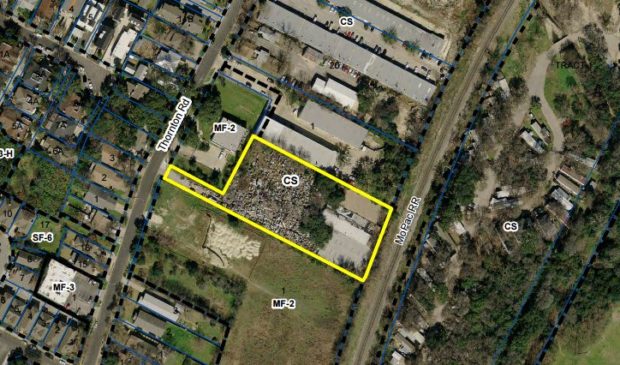Planning Commission OKs Thornton apartments over neighbor objections
Thursday, June 30, 2016 by
Jack Craver The increased traffic might not be ideal, but neighbors opposed to a proposed 70-unit apartment building on Thornton Road are getting about as good a deal as they can expect from the land, suggested members of the Planning Commission on Tuesday.
The panel voted to recommend a zoning change requested by the developer, PSW Real Estate, for the 1.73-acre parcel that is currently occupied by a junkyard. The panel approved the zoning 10-1, with Commissioner Tom Nuckols dissenting and commissioners Jeffrey Thompson and Fayez Kazi absent.
The recommendation came despite objections voiced by leaders of the South Lamar Neighborhood Association, who complained that Thornton Road was ill-equipped for the increased traffic that would result from newcomers.
The same group helped persuade City Council in March to block a mixed-use development proposed by a different developer just down the street, at 2303 and 2309 Thornton Road. That project, however, was not only about three times larger, but would also have displaced Thornton Road Studios, an arts collective in a neighborhood long known as a home to the creative economy.
Glen Coleman, a representative for PSW, told the commission that the apartments would be a far superior outcome for the neighborhood than what the developer originally envisioned for the property: a 75,000-square-foot office building, which the current zoning would allow. That project would produce nearly twice as many vehicle trips on Thornton Road, he said.
Of the 70 units, PSW pledges that seven will be reserved for those with incomes at 60 percent of the area median family income for 40 years. If approved, the project will essentially be an extension of an adjacent 104-unit apartment building that PSW has nearly completed.
The major traffic increase that an office building would have generated for the residents of that first development was one of the reasons that PSW decided to change course and pursue additional residential units, said Coleman, who dubbed the two projects “Thornton I” and “Thornton II.”
PSW’s requested zoning did not get the endorsement of city staff, who instead recommended a less-dense MF-2 zoning, which would allow for 39 units. Coleman said that the developer would not be interested in trading the office building for such a small residential development.
Kim Johnson, president of the South Lamar Neighborhood Association, said that the current commercial zoning was a mistake but that the group still opposed the requested zoning change. He rejected the premise that the current zoning would necessarily lead to an enormous office building. “It doesn’t have to be that dense of a commercial property,” he said.
Some of the commissioners appeared baffled by the opposition.
“You have a plan in front of you that would essentially cut your traffic in half from what they could do now,” said Commissioner Chito Vela. “It’s going to at least limit the damage.”
Under the current zoning, added Commissioner Patricia Seeger, the developer could build a much larger development without even consulting with the city, and thus without receiving feedback from the neighborhood. But by requesting the zoning change, she said, “you’re part of the discussion.”
Seeger also cited the affordable housing that is part of the development and the “rough proportionality” payment that the developer will be required to pay to the city for infrastructure improvements that the development necessitates.
Johnson suggested that whatever the developer will pay for infrastructure improvements will fall far short of the roughly $500,000 that he said is needed. Coleman later told the Austin Monitor that the anticipated payment will likely be a tad under $200,000.
Furthermore, Johnson pointed out, while the payment for improvements may be required, there is little guarantee that the city will undertake the infrastructure projects in the immediate future, especially because the payment wouldn’t cover the widening of Thornton Road that city staff recommended to accompany the 70-unit building.
That complaint resonated with Nuckols, who said that the larger office development might “perversely” leave the neighborhood in a better situation in terms of traffic, since it would likely result in a payment from the developer that would actually cover the cost of the necessary infrastructure improvements. He would be able to support the new zoning if he could be assured that the road fixes would be made.
“It’s an odd place we find ourselves in,” Nuckols concluded.
The rest of the dais appeared happy with the developer’s proposal, particularly the assurance that the project would include affordable units and abide by SMART housing principles — so they were all the more disappointed when a city attorney told them that state law barred them from making affordability or SMART housing a condition of granting zoning.
While Thornton I was able to partake in the city’s SMART housing density bonus program, the city determined that Thornton II would not be eligible for the same program because the existing property is not a greenfield, Coleman told the commission.
He nevertheless assured the commission that PSW, which markets itself as an urbanist developer, would pursue the affordable units and SMART housing regardless.
“It’s part of the DNA of that company,” he said.
The commission opted to approve a motion with a “strong recommendation” that affordable units be included in the development.
Zoning map courtesy of the city of Austin
You're a community leader
And we’re honored you look to us for serious, in-depth news. You know a strong community needs local and dedicated watchdog reporting. We’re here for you and that won’t change. Now will you take the powerful next step and support our nonprofit news organization?



